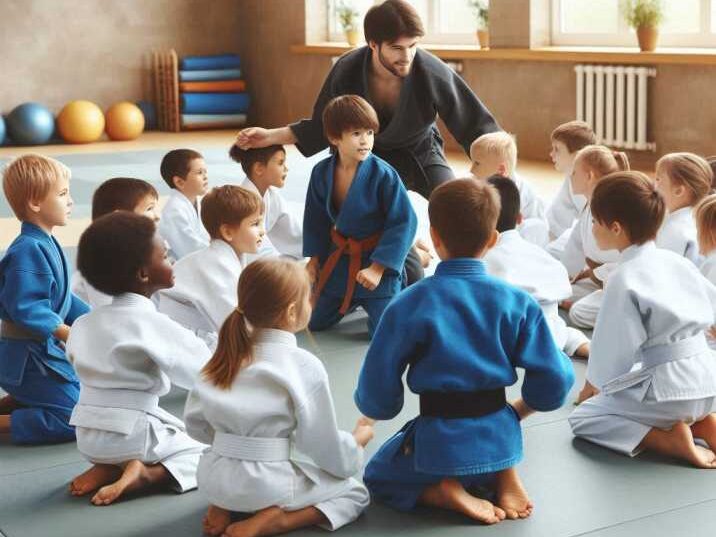Introduction
Table of Contents
Choosing the right martial art for your child can feel overwhelming. With so many options, you want something safe, structured, and beneficial. Many parents look at judo because it balances discipline, fitness, and fun.
Unlike martial arts that focus on striking, judo emphasizes throws, holds, and control. This makes it appealing for children who want to learn self-defense without constant kicking and punching.
In this guide, we will explain judo rules in simple words, show you the Judo rules and best styles for children, highlight safety tips, and answer common parent questions. By the end, you will feel confident deciding if judo is the right path for your child.

What is Judo?
Judo is a Japanese martial art created in 1882 by Jigoro Kano. The word “judo” means “gentle way.” The focus is on using balance, timing, and technique instead of brute force.
Children in judo learn how to throw opponents safely, control them on the ground, and respect rules. Matches are less about hurting and more about skill, making it one of the safest martial arts for kids.
Judo Rules Explained for Parents and Kids
Here are the basic judo rules your child will learn:
Respect comes first
Every judo class begins and ends with a bow. This simple action teaches children to respect their coach, training partners, and the sport. It reminds kids that judo is not about fighting but about learning and growing together. Respect is a core value that carries over into daily life.
No striking
Unlike karate or taekwondo, judo does not involve punches or kicks. This makes the practice safer for young children and reduces the risk of injuries. Kids focus on throws, holds, and balance instead of hitting. Parents can feel reassured knowing the emphasis is on skill, not force.
Scoring points
In judo training, points are earned by cleanly throwing an opponent on their back or holding them down for a set time. This helps children understand the value of control and technique over strength. Kids learn that winning comes from precision, not aggression. Scoring builds motivation and encourages progress.
Match time
Children’s matches are shorter than adult matches, usually lasting only 2–3 minutes. This prevents exhaustion and keeps kids focused on learning rather than pushing their physical limits. Shorter matches also ensure children remain safe and enjoy the experience without burnout.
Safety first
Techniques that could harm children, such as joint locks or chokes, are not allowed. Instructors focus on teaching safe throws and proper falling techniques to protect kids during practice. Safety rules help build trust, so children can learn confidently without fear of injury.
Proper gear
Every child must wear a judogi, the traditional judo uniform. It is designed to be strong enough for gripping and durable for throws. Wearing the right gear keeps training fair and safe while giving kids a sense of belonging. The judogi also helps reinforce discipline and respect for the sport.
These rules create a safe, respectful, and structured environment.
Benefits of Judo for Children
1. Builds physical strength and balance
Judo training includes throws, rolls, and controlled falls that strengthen a child’s body. These movements improve balance, coordination, and flexibility. Regular practice also develops endurance and agility. Over time, kids become stronger and more confident in how they move.
2. Teaches discipline and focus
Judo follows a structured routine where children bow, listen, and follow instructions carefully. This helps kids develop patience and self-control in a supportive environment. Learning to stay focused on techniques carries over into school and daily life. Discipline becomes a natural habit, not a forced rule.
3. Promotes confidence and resilience
In judo training, children experience both victories and defeats. Winning builds pride, while losing teaches perseverance and courage. Each challenge helps them grow stronger mentally and emotionally. This resilience supports them in handling setbacks outside the dojo as well.
4. Social skills and friendships
Judo is practiced with partners, which encourages teamwork and cooperation. Kids learn to respect others while working together to improve. Many form lasting friendships through shared practice and competitions. These social bonds make training more enjoyable and motivating.
5. Safe self-defense skills
Judo training gives children effective tools to defend themselves without relying on striking. They learn how to control an opponent through balance and technique. This builds confidence in their ability to handle tough situations. The focus remains on protection and safety, not aggression.

Possible Risks or Concerns
Minor falls and bruises during practice
Because judo styles involves throws and grappling, children may experience small bumps or bruises. These are normal in active sports and usually heal quickly. With padded mats and proper falling techniques, the risk of serious injury is very low. Most kids adapt to the physical contact over time.
Overtraining if classes are too frequent
Training too often can cause fatigue or muscle soreness. Young children need time to rest and recover. Parents should make sure schedules are balanced with school, play, and sleep. A couple of classes per week is usually enough for steady progress.
Fear of falling for very young children
Some kids may feel nervous about being thrown or learning how to fall. Instructors teach falling techniques step by step to reduce fear. Over time, children gain confidence and realize they can fall safely. This actually helps them avoid injuries in everyday life.
Safety Tips for Parents
Choose a certified dojo with experienced coaches
Look for schools with qualified instructors who understand child development. Certification ensures proper training methods and safe instruction. A good coach will focus on safety before competition.
Ask if the school separates age and skill levels
Children should train with others close to their size and experience. This prevents mismatched pairings that could cause injuries. Age-appropriate groups also make kids feel more comfortable and confident.
Check that mats are padded and clean
Good quality mats absorb impact and reduce the chance of injury. Cleanliness is also important to prevent skin infections. Parents should check the training area before enrolling their child.
Encourage your child to listen to their body and rest when needed
Kids should learn to recognize when they are tired or sore. Rest days are just as important as training days. This helps prevent burnout and injuries caused by fatigue.
Provide the right judogi and belt
A proper judo uniform is strong enough to handle grips and throws. The belt shows a child’s rank and progress, which keeps them motivated. Wearing the correct gear also ensures safety and fairness.
Stay engaged by watching classes and talking with instructors
Parents who observe classes show support and stay informed. Talking with the coach helps you understand your child’s progress and any concerns. This builds trust between you, your child, and the dojo.
Best Judo Styles for Children
Competitive judo
This approach focuses on preparing kids for tournaments and scoring points. It builds discipline, goal-setting, and resilience under pressure. Competitive judo is best for children who enjoy challenges and structured goals. It also teaches sportsmanship through real match experiences.
Traditional judo
Traditional training emphasizes respect, culture, and the original values of judo. Children learn discipline, etiquette, and the meaning of the martial art beyond competition. This style is ideal for parents who want character development alongside physical skills
Recreational judo
Recreational practice focuses on fitness, fun, and social interaction. Kids can enjoy judo without the pressure of competing. This is often the best option for beginners or shy children. It builds confidence while keeping training light and enjoyable.
For most children under 12, recreational or traditional judo is the best starting point. As they grow, they can choose to compete.
Comparison: Judo vs Other Martial Arts for Kids
| Martial Art | Main Focus | Good For | Risks |
|---|---|---|---|
| Judo | Throws, holds, ground control | Balance, discipline, safe self-defense | Minor falls |
| Karate | Punches, kicks | Confidence, striking skills | Risk of bruises |
| Taekwondo | High kicks, speed | Flexibility, tournaments | Risk of ankle injuries |
| Brazilian Jiu-Jitsu (BJJ) | Ground grappling | Self-defense, strategy | Some joint pressure |
| Kung Fu | Forms, traditional moves | Discipline, cultural value | Complex for younger kids |
Table Summary
| Benefits of Judo for Kids | Risks/Concerns |
|---|---|
| Builds strength and balance | Minor bruises |
| Teaches focus and discipline | Overtraining |
| Improves confidence | Fear of falling |
| Encourages teamwork | Needs supervision |
| Safe self-defense | Limited if poorly taught |
Conclusion
Judo is one of the best martial arts for children. It builds strength, discipline, and confidence while teaching respect and teamwork.
Parents can feel comfortable knowing judo rules keep kids safe, and the environment is supportive. Whether your child is outgoing or shy, judo offers a positive path for growth.
If you want a martial art that balances fitness, self-defense, and life lessons, judo is an excellent choice. Encourage your child to try a class, meet the coach, and see how they enjoy it.
FAQs
Q1: At what age can my child start judo?
Most kids start at age 5 or 6, when they can follow instructions and handle group activities.
Q2: Is judo safe for small or shy children?
Yes. Judo focuses on technique, not size or strength. It can help shy kids build confidence.
Q3: Do kids need special gear for judo?
Only a judogi (judo uniform) and belt are needed. These are affordable and durable.
Q4: Can judo help with school performance?
Yes. Many parents notice improved focus, patience, and self-control after their child starts judo.
Q5: Is judo better than karate or taekwondo for kids?
Not necessarily better, but safer for beginners since it avoids punching and kicking.


